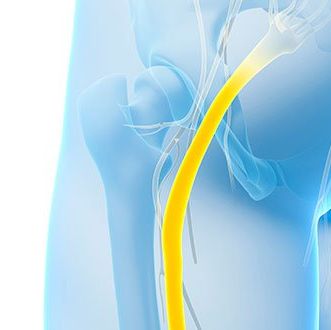Sciatica Treatment in Bangladesh: with Natural Medicine 2023
The best sciatica treatment in Bangladesh is a combination of conservative options, such as pain medication, physical therapy, and targeted exercises. By following these treatments, individuals can experience relief from sciatic nerve pain and improve their overall quality of life.
Sciatica, a painful condition characterized by radiating pain from the lower back down through the legs, can greatly affect a person’s daily activities and mobility. It occurs when the sciatic nerve, the longest nerve in the body, becomes compressed or irritated.
While various treatments are available, finding the best sciatica treatment in Bangladesh is essential for long-term pain relief and recovery. The most effective approach involves a combination of conservative methods, including pain medication, physical therapy, and targeted exercises. These options not only alleviate symptoms but also address the underlying causes of sciatica, such as muscle imbalances and spinal misalignments. By adhering to these treatment methods, individuals can find relief, improve their mobility, and enhance their overall well-being.
/assets/production/practices/c3fd610b5a915563a4b13a6f06cb75648cede47d/images/2518441.jpg)
Credit: www.ipttherapysolutions.com
Understanding Sciatica: What You Need To Know
Discover the best sciatica treatment in Bangladesh for effective pain relief. Gain a deep understanding of sciatica and what you need to know about this condition.
Living with sciatica can be a daily struggle, with its debilitating pain and discomfort. In order to find the best treatment for this condition, it is important to understand what sciatica is and what causes it. This knowledge will help you navigate the various treatment options available and make informed decisions about managing your pain.
In this section, we will delve into the definition and causes of sciatica.
Definition And Causes Of Sciatica:
- Sciatica is a condition that causes pain, tingling, and numbness along the sciatic nerve, which runs from the lower back down to the legs.
- This condition is usually caused by a herniated or bulging disc in the spine that puts pressure on the sciatic nerve.
- Other possible causes of sciatica include spinal stenosis, spondylolisthesis, muscle strain, and trauma to the spine.
- Pregnancy can also lead to sciatica due to the pressure exerted on the sciatic nerve by the growing uterus.
- Additionally, conditions such as obesity, prolonged sitting, and certain occupations that involve heavy lifting or twisting movements can contribute to the development of sciatica.
Understanding the definition and causes of sciatica is the first step in managing this condition effectively. It allows you to identify potential triggers and take appropriate measures to alleviate the associated pain and discomfort. In the next section, we will explore how sciatica can impact your daily life and the challenges it presents.
Diagnosis And Assessment Of Sciatica
Diagnosis and assessment of sciatica is crucial for determining the best treatment options. Expert evaluation helps in identifying the underlying cause, severity, and appropriate interventions for effective management of sciatic nerve pain.
Symptoms And Signs Of Sciatica
- Pain radiating from the lower back to the buttocks, thighs, and legs.
- Numbness or tingling sensation in the affected leg.
- Muscle weakness in the leg or difficulty in moving the leg or foot.
- Pain exacerbated by sitting or standing for long periods.
- Shooting or sharp pain that makes it challenging to walk or stand.
Medical Tests For Diagnosing Sciatica
- Physical examination: A thorough assessment of the patient’s medical history and physical symptoms is conducted to determine the likelihood of sciatica.
- Straight leg raise test: This test involves lifting the leg while keeping the knee straight to check for pain and limited range of motion, which may indicate nerve compression.
- Imaging tests: X-rays, ct scans, and mri scans help identify the underlying cause of sciatica, such as a herniated disc or bone spur.
- Electromyography (emg): This test measures the electrical activity of the muscles and nerves to determine if there is nerve damage or compression.
- Nerve conduction studies: Electrodes are placed on the skin to measure the speed and strength of the electrical signals transmitted by the nerves.
Severity Grading And Assessment
- Mild sciatica: Pain is manageable and does not significantly interfere with daily activities. There may be occasional discomfort or mild symptoms.
- Moderate sciatica: Pain is moderate and may disrupt regular activities. Symptoms persist for longer periods, and there is noticeable muscle weakness or limited mobility.
- Severe sciatica: Pain is intense and debilitating, making it challenging to perform daily tasks. There may be severe muscle weakness, decreased sensation, or difficulty controlling bowel or bladder function.
- Assessment tools: Healthcare professionals use various scales and questionnaires, such as the visual analog scale (vas) or the oswestry disability index (odi), to assess the severity of sciatica and its impact on the patient’s quality of life.
Remember, early and accurate diagnosis is crucial in determining the appropriate treatment plan for sciatica. It is recommended to consult a healthcare professional for an accurate diagnosis and personalized treatment options based on individual circumstances.
Physical Therapy And Exercise
Physical therapy and exercise are essential components of the best sciatica treatment in Bangladesh, as they help alleviate pain and improve mobility. Through targeted exercises and hands-on techniques, physical therapists can address underlying causes of sciatica and provide effective relief.
Benefits Of Physical Therapy For Sciatica:
- Physical therapy is a highly effective treatment for sciatica, offering several benefits for patients.
- By targeting the underlying cause of sciatica, physical therapy can provide long-term relief and prevent future episodes.
- Some of the key benefits of physical therapy for sciatica include:
- Pain relief: Physical therapy helps reduce pain through targeted exercises and manual therapy techniques.
- Improved mobility: Specific exercises and stretches can restore flexibility and improve range of motion in the affected area.
- Strengthening muscles: Physical therapy focuses on strengthening the muscles surrounding the sciatic nerve, providing better support and stability.
- Posture correction: Therapists can help identify and correct poor posture habits, which may contribute to sciatica.
- Education and self-management: Physical therapists educate patients on self-management strategies, empowering them to manage their symptoms independently.
Recommended Exercises And Stretches For Sciatica Relief:
- Engaging in certain exercises and stretches can help alleviate sciatica symptoms and promote healing.
- Here are some recommended exercises and stretches for sciatica relief:
- Hamstring stretches: Gentle stretching exercises targeting the hamstrings can relieve tension in the lower back and reduce sciatic nerve pressure.
- Piriformis stretches: Stretching the piriformis muscle can help ease pain and pressure on the sciatic nerve.
- Lumbar stabilization exercises: Strengthening the core and lower back muscles can improve stability and alleviate sciatica symptoms.
- Low-impact cardiovascular exercises: Activities like swimming or walking can promote circulation and reduce inflammation, aiding in sciatica recovery.
- Yoga and stretching routines: Specific yoga poses and stretching routines can lengthen tight muscles, improving flexibility and reducing nerve compression.
Posture And Ergonomics For Preventing And Managing Sciatica:
- Maintaining proper posture and ergonomics is essential for preventing and managing sciatica.
- Here are some tips for maintaining a healthy posture and ergonomics to reduce the risk of sciatica:
- Practice good sitting posture: Sit with your back straight, shoulders relaxed, and feet flat on the floor. Use a chair with proper lumbar support.
- Avoid prolonged sitting or standing: Take regular breaks and change positions frequently to avoid excessive pressure on the sciatic nerve.
- Use ergonomic equipment: Ensure that your workspace is ergonomically designed, with an adjustable chair, supportive keyboard, and monitor at eye level.
- Lift with proper technique: When lifting heavy objects, bend at the knees, keep your back straight, and use your leg muscles to lift.
- Maintain a healthy weight: Excess weight can put additional strain on the lower back and exacerbate sciatica symptoms. Maintain a healthy diet and exercise regularly.
Remember that while physical therapy, exercises, and postural adjustments can be effective in managing sciatica, it is always recommended to consult with a healthcare professional for proper diagnosis and personalized treatment plan.
Medications For Sciatica Relief in Bangladesh
Discover the best medications to relieve sciatica pain and discomfort. Explore options that effectively target the root cause, providing much-needed relief from this common condition.
If you’re dealing with sciatica, finding the right treatment is crucial to alleviate the pain and discomfort. In addition to physical therapy and alternative treatments, medications can be a valuable tool for managing the symptoms. In this section, we’ll explore some commonly prescribed medications for sciatica, pain management options, as well as potential side effects and precautions to keep in mind.
Commonly Prescribed Medications For Sciatica
When it comes to medicating sciatica, healthcare professionals often recommend specific drugs to help reduce pain and inflammation. Here are some commonly prescribed medications for sciatica relief:
- Nsaids (non-steroidal anti-inflammatory drugs): These medications, such as ibuprofen and naproxen, can help alleviate pain and reduce inflammation. They work by blocking certain chemicals that cause pain and swelling.
- Oral steroids: In some cases, doctors may prescribe oral steroids, such as prednisone, to help reduce inflammation and relieve sciatica symptoms. However, these medications are typically used for short-term relief due to potential side effects.
- Muscle relaxants: If muscle spasms accompany your sciatica pain, your doctor may recommend muscle relaxants like cyclobenzaprine or methocarbamol. These drugs help relax the muscles and reduce spasms.
Pain Management Medication Options
Managing the pain associated with sciatica is crucial for improving your quality of life. Alongside the medications mentioned above, here are a few other pain management options commonly used for sciatica:
- Opioids: In severe cases of sciatica pain, opioids like codeine or oxycodone may be prescribed. These medications are powerful pain relievers but should be used cautiously due to the potential for addiction and other side effects.
- Tricyclic antidepressants: Although primarily used to treat depression, tricyclic antidepressants like amitriptyline can also help alleviate nerve pain, including sciatica. They work by affecting certain chemicals in the brain and can improve sleep quality as well.
- Topical medications: Creams or patches containing capsaicin, lidocaine, or menthol can be applied directly to the affected area to provide localized pain relief. These topical medications work by numbing the skin or reducing pain signals.
- Anticonvulsants: Drugs like gabapentin or pregabalin, originally developed to treat epilepsy, have shown effectiveness in treating nerve pain. These medications work by reducing abnormal electrical activity in the nerves.
Potential Side Effects And Precautions
While medications can be effective in managing sciatica symptoms, it is important to be aware of potential side effects and take necessary precautions. Here are some important points to consider:
- Nsaids may cause stomach irritation or increase the risk of bleeding. It is essential to take them with food and follow the recommended dosage.
- Oral steroids, if used for an extended period, can lead to side effects such as weight gain, mood changes, and high blood pressure. They should be tapered off gradually after use.
- Muscle relaxants may result in drowsiness or dizziness, affecting your ability to perform certain activities. Avoid combining them with alcohol or operating heavy machinery.
- Opioids should only be used under the supervision of a healthcare professional due to the risk of addiction, overdose, and respiratory depression. They should be taken as prescribed to minimize these risks.
- Some medications may interact with other drugs or medical conditions. It is important to inform your healthcare provider about your complete medical history and current medications to avoid potential complications.
Remember, every individual is unique, and the choice of medication may vary based on your specific condition and response. It is essential to consult with your healthcare provider to determine the best course of treatment and to address any concerns or questions you may have regarding medications for sciatica relief.
Alternative Therapies For Sciatica Relief
Looking for the best sciatica treatment in Bangladesh? Explore alternative therapies for sciatica relief. Discover effective methods to alleviate pain and improve overall well-being.
Chiropractic Care And Manipulations
Chiropractic care and manipulations can offer effective relief for sciatica. Here are some key points to consider:
- Chiropractic adjustments: Skilled chiropractors can perform spinal adjustments to realign the spine, reducing pressure on the sciatic nerve and alleviating pain.
- Non-invasive approach: Chiropractic care focuses on non-surgical treatments, making it a popular choice for those seeking alternative therapy for sciatica.
- Improved mobility: Chiropractic adjustments can help improve range of motion, allowing for better movement and reduced discomfort.
- Tailored treatment plans: Chiropractors assess each patient individually, developing personalized treatment plans that address specific sciatica symptoms.
- Collaboration with other specialists: Chiropractors often work in collaboration with other healthcare professionals to provide holistic care, ensuring the best possible outcomes for sciatica patients.
Acupuncture And Acupressure For Sciatica
Ancient practices like acupuncture and acupressure have gained popularity as alternative therapies for sciatica relief. Consider the following:
- Reduction of pain signals: Acupuncture involves the insertion of thin needles into specific points on the body to stimulate the nervous system, promoting pain relief and reducing inflammation.
- Restoring energy balance: Acupuncture and acupressure aim to rebalance the body’s energy flow, known as qi, which may be disrupted in cases of sciatica.
- Improved blood circulation: Acupuncture can enhance blood flow, which aids in the delivery of oxygen and nutrients to the affected area, helping to accelerate the healing process.
- Non-pharmacological approach: Acupuncture and acupressure offer a drug-free approach to managing sciatica symptoms, minimizing the risks of medication side effects.
- Individualized treatment: Licensed acupuncturists customize treatment plans based on the patient’s specific needs and symptoms, ensuring personalized care.
Massage Therapy And Its Benefits For Sciatic Pain
Massage therapy can provide significant relief from sciatic pain. Here’s why it is considered an effective alternative therapy:
- Relaxation and stress reduction: Massage therapy can promote relaxation, reducing muscle tension and stress that can exacerbate sciatica symptoms.
- Increased circulation: Proper manipulation of soft tissues during massage improves blood circulation, reducing inflammation and promoting healing.
- Release of endorphins: Massage stimulates the release of endorphins, the body’s natural painkillers, which can help manage sciatic pain without relying solely on medication.
- Improved flexibility: Regular massage can help improve muscle flexibility, reducing the risk of worsening sciatica symptoms due to tight muscles.
- Professional guidance: Consulting a licensed massage therapist ensures that the treatment targets the affected areas and follows safe techniques suitable for sciatica relief.
Remember, when seeking alternative therapies for sciatica relief, it is essential to consult with qualified healthcare professionals to ensure the best course of treatment for your specific condition.
Microdiscectomy
Microdiscectomy is a highly effective treatment for sciatica, providing relief from pain and promoting healing. This minimally invasive procedure removes the herniated disc causing the compression on the sciatic nerve, addressing the root cause of the problem.
How Microdiscectomy Helps In Treating Sciatica:
Microdiscectomy is a surgical procedure commonly used to treat sciatica caused by a herniated disc pressing on the sciatic nerve. This minimally invasive procedure aims to remove a small portion of the herniated disc material, relieving pressure on the nerve and reducing pain and other symptoms.
Here are some key points about how microdiscectomy helps in treating sciatica:
- Minimally invasive: Microdiscectomy is a minimally invasive procedure, meaning that it requires smaller incisions compared to traditional open surgery. This leads to less tissue damage, minimal scarring, and a faster recovery time for patients.
- Nerve decompression: The main goal of microdiscectomy is to decompress the affected nerve root. By removing the herniated disc material that is pressing on the nerve, the procedure alleviates the compression and allows the nerve to heal.
- Pain relief: Microdiscectomy often provides immediate relief from sciatic pain. Once the pressure on the nerve is relieved, patients experience a significant reduction in pain and discomfort.
- Improved mobility: Sciatica can severely limit mobility due to pain, weakness, and numbness in the affected leg. Can improve mobility by addressing the underlying cause of sciatica and restoring normal nerve function.
- Outpatient procedure: In most cases, microdiscectomy is performed as an outpatient procedure, meaning that patients can go home the same day. This reduces hospital stay and allows individuals to recover in the comfort of their own homes.
Recovery And Rehabilitation Process:
After undergoing microdiscectomy for sciatica, it is essential to follow the proper recovery and rehabilitation process to ensure the best possible outcome. Here’s what you can expect:
- Hospital stay: As mentioned earlier, microdiscectomy is typically performed as an outpatient procedure, which means there is no hospital stay. However, there might be a short observation period immediately after surgery to ensure your well-being.
- Discomfort and pain: It is normal to experience some discomfort or pain following microdiscectomy. Your surgeon may prescribe pain medications to manage any postoperative pain.
- Physical activity: While it is important to rest and avoid strenuous activities during the initial recovery period, your surgeon will advise you on gradually resuming light activities and exercises. Physical therapy may also be recommended to strengthen your back and improve flexibility.
- Return to work: The timing of returning to work will depend on the nature of your job and your recovery progress. Sedentary jobs may allow a quicker return, while physically demanding occupations might require a longer period of rest and rehabilitation.
- Follow-up appointments: Your surgeon will schedule follow-up appointments to monitor your progress. These appointments are essential for assessing your healing process and addressing any concerns or complications that may arise.
Remember, each individual’s recovery process may vary. It is crucial to follow your surgeon’s instructions and engage in open communication to optimize your recovery after microdiscectomy.
With advances in surgical techniques, microdiscectomy has become an effective treatment option for sciatica caused by a herniated disc. By understanding how microdiscectomy works and what to expect during recovery, you can make informed decisions about your sciatica treatment journey.
Spinal Decompression Therapy
Spinal decompression therapy provides effective relief for sciatica pain, promoting healing without surgery or medication. This gentle treatment gently stretches the spine to relieve pressure on compressed nerves, reducing symptoms and improving quality of life.
Understanding Spinal Decompression Therapy For Sciatica
Spinal decompression therapy is a non-surgical treatment option for relieving the symptoms associated with sciatica. This therapy involves stretching the spine gently to relieve pressure on the compressed nerves and discs in the lower back. By creating negative pressure, spinal decompression promotes the movement of oxygen, water, and nutrients into the discs, helping them heal and reducing inflammation.
Here’s what you need to know about spinal decompression therapy for sciatica:
Benefits Of Spinal Decompression Therapy:
- Pain relief: Spinal decompression therapy can provide significant pain relief for individuals suffering from sciatica by relieving pressure on the affected nerves.
- Non-invasive: Unlike surgery, spinal decompression therapy is a non-invasive treatment option. It does not involve any incisions or anesthesia, making it a safer alternative for those who want to avoid surgery.
- Quick and convenient: Each spinal decompression session typically lasts between 20-30 minutes, and most patients see significant improvement within just a few weeks of treatment.
- Improved mobility: By reducing pressure on the nerves in the lower back, spinal decompression therapy can help improve mobility and function, allowing individuals to engage in daily activities with less pain and discomfort.
Risks Of Spinal Decompression Therapy:
- Not suitable for everyone: Spinal decompression therapy is not recommended for individuals with certain conditions such as osteoporosis, fractures, tumors, or significant spinal instability.
- Temporary soreness: Some patients may experience temporary soreness or discomfort after a spinal decompression session. However, this discomfort usually subsides within a few hours and can be managed with ice or over-the-counter pain medication.
Success Rates Of Spinal Decompression Therapy:
- Positive outcomes: Studies have shown that spinal decompression therapy can be effective in relieving symptoms of sciatica, with many patients experiencing a significant reduction in pain and improvement in overall function.
- Individual results may vary: It’s important to note that the success of spinal decompression therapy can vary from person to person. Factors such as the severity of sciatica symptoms and the individual’s overall health can influence the outcomes of the treatment.
Spinal decompression therapy is a non-invasive treatment option that can provide significant pain relief and improved function for individuals suffering from sciatica. While it may not be suitable for everyone and temporary soreness can occur, many patients have had positive outcomes with this therapy.
If you’re considering spinal decompression therapy for sciatica, consult with a qualified healthcare professional to determine if it is the right treatment option for you.
Laser Spine Surgery
Laser spine surgery offers the best sciatica treatment, providing effective relief from pain and discomfort. This minimally invasive procedure utilizes advanced technology to target and treat the underlying cause of sciatica, helping patients regain their mobility and improve their quality of life.
Overview Of Laser Spine Surgery As A Treatment For Sciatica
Laser spine surgery has emerged as a groundbreaking treatment option for individuals suffering from sciatica. This minimally invasive procedure utilizes advanced laser technology to target and address the root causes of sciatic nerve pain. By offering a precise and efficient solution, laser spine surgery has garnered attention as a viable alternative to traditional open back surgery.
In this section, we will explore the minimally invasive nature of laser spine surgery and its potential benefits.
Minimally Invasive Nature And Potential Benefits
Laser spine surgery offers several advantages over conventional surgical methods, making it an appealing choice for sciatica treatment. Here are some key points to consider:
- Reduced tissue damage: The minimally invasive nature of laser spine surgery means that there is minimal disruption to surrounding tissues, muscles, and structures. This can lead to reduced postoperative pain and a shorter recovery time.
- Precise targeting: Laser technology allows surgeons to specifically target affected areas with utmost precision, ensuring that the sciatic nerve is relieved from compression or impingement. This targeted approach can result in more successful outcomes for patients.
- Minimal scarring: With smaller incisions involved in laser spine surgery, patients can expect minimal scarring compared to traditional open surgeries. This aesthetic benefit can boost confidence and contribute to an overall positive experience.
- Shorter hospital stays: The less invasive nature of laser spine surgery often leads to shorter hospital stays compared to more invasive procedures. This means that patients can often return to the comfort of their homes sooner, facilitating a smoother recovery process.
- Faster recovery: As laser spine surgery is less traumatic to the body, individuals typically experience a faster recovery compared to traditional open back surgery. This can allow them to resume their daily activities and regain functionality more quickly.
- Lower risk of complications: Laser spine surgery carries a lower risk of complications due to its minimally invasive nature. This can provide peace of mind for individuals considering this treatment option as they anticipate a successful recovery.
By offering a minimally invasive approach with potential benefits such as reduced tissue damage, precise targeting, minimal scarring, shorter hospital stays, faster recovery, and a lower risk of complications, laser spine surgery has emerged as an attractive treatment choice for those experiencing sciatica.
Always consult with a healthcare professional to determine if this procedure is the right fit for your specific case.
Lifestyle Modifications For Sciatica Prevention
Lifestyle modifications can help prevent sciatica symptoms. By incorporating regular exercise, maintaining a healthy weight, practicing good posture, and avoiding prolonged sitting or heavy lifting, individuals can reduce the risk of sciatica and improve overall well-being.
Maintaining a healthy weight:
- Achieve and maintain a healthy weight to reduce the strain on your lower back.
- Excess weight can put additional pressure on the spinal discs and increase the risk of developing sciatica.
- Follow a balanced diet and engage in regular physical activity to manage your weight effectively.
- Consult a healthcare professional or a registered dietitian for personalized weight loss guidance.
Proper body mechanics and lifting techniques:
- Use proper body mechanics when lifting heavy objects to prevent excessive strain on the back.
- Bend at the knees and lift with your legs instead of your back.
- Avoid twisting motions while lifting and carry heavy items close to your body.
- If necessary, ask for assistance or use lifting aids to minimize the risk of injury.
Tips for improving posture and reducing stress on the spine:
- Maintain good posture throughout the day to reduce pressure on the spine.
- Sit and stand with your back straight, shoulders relaxed, and chin parallel to the ground.
- Use ergonomic furniture, such as a supportive chair and an adjustable desk, to maintain a neutral spine position.
- Take frequent breaks from prolonged sitting or standing to stretch and move around.
Reducing stress on the spine:
- Engage in exercises that promote core strength and flexibility, such as yoga or pilates.
- Strengthening the core muscles can provide better support for the spine and reduce the risk of sciatica.
- Practice stress management techniques, such as meditation or deep breathing exercises, to help relieve tension in the muscles surrounding the spine.
- Avoid activities that involve repetitive or excessive bending, twisting, or lifting, as they can strain the back and lead to sciatica symptoms.
Remember, making these lifestyle modifications and incorporating healthy habits can significantly prevent sciatica and improve your overall well-being. By maintaining a healthy weight, using proper lifting techniques, improving your posture, and reducing stress on the spine, you can minimize the risk of experiencing sciatica discomfort.
Frequently Asked Questions On Best Sciatica Treatment
What Is Sciatica And What Are The Symptoms?
Sciatica is a condition that causes pain along the sciatic nerve, usually radiating from the lower back down one leg. Symptoms include sharp pain, numbness, tingling, and weakness in the affected leg.
What Are The Causes Of Sciatica?
Sciatica is usually caused by a herniated disk in the spine, which puts pressure on the sciatic nerve. Other causes include spinal stenosis, degenerative disc disease, and muscle spasms.
How Is Sciatica Diagnosed And Treated?
Diagnosis of sciatica involves a physical exam and medical history review, along with imaging tests like x-rays or mri scans. Treatment options may include pain medication, physical therapy, hot/cold therapy, and in severe cases, surgery.
Can Sciatica Be Prevented?
While it’s not always possible to prevent sciatica, there are some steps you can take to reduce the risk. These include maintaining good posture, regularly exercising to strengthen the back and core muscles, and avoiding prolonged sitting or heavy lifting.
When Should I See A Doctor For Sciatica?
You should see a doctor for sciatica if the pain is severe, persistent, or if it is accompanied by bladder or bowel control problems. Additionally, if the pain is getting worse despite conservative treatments or if it is affecting your daily activities, it’s best to seek medical attention.
Conclusion
Sciatica can be a debilitating condition that affects many individuals, but with the right treatment, relief is possible. By understanding the causes and symptoms of sciatica, you can take proactive steps to address the issue. The best sciatica treatment is a combination of various approaches, including physical therapy, exercise, and medication.
Physical therapy can help strengthen the muscles and improve flexibility, reducing the pressure on the sciatic nerve. Regular exercise, such as walking or swimming, can also alleviate symptoms and promote healing. Additionally, medications like pain relievers and anti-inflammatories can provide temporary relief.
It is important to consult with a healthcare professional to tailor a treatment plan that suits your needs. Remember, everyone’s journey with sciatica is different, so be patient as you find the best treatment option for you. With the right approach, you can manage your sciatica and get back to enjoying a pain-free life.

Dr. Helal, uniting science and nature for holistic health. Pioneering natural medicine for balanced living.








